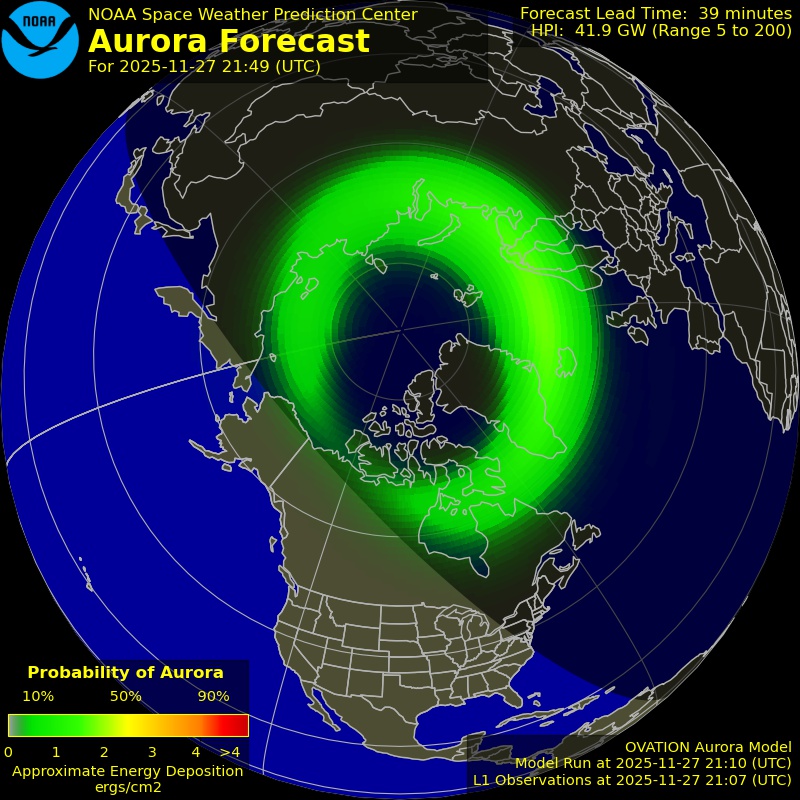Aurora Australis Forecast for Victoria
Substorm
Substorm Phase: Quiet; Aurora Activity Score: 15/100
Don’t Miss the Magic!
Stay ahead of the Northern Lights with real-time alerts. Subscribe now to receive a text or call whenever the aurora is active—so you never miss a moment of the show.
When and Where to See the Aurora Australis in Victoria
The best time to see the Aurora Australis in Victoria is around winter and the equinox in September, but it can be visible throughout the year depending on solar activity. Check the space weather forecast to predict solar activity, which influences the visibility of auroras.
The Southern Lights always come from the south, and Victorian viewers usually see the “top” of the aurora. A bright aurora display generally lasts around one to three hours, and is typically brightest between 10pm and 2am. Look south, preferably over the ocean, where it’s dark and flat, to minimize light pollution from city lights.
National Parks and Coastal Areas
- Wilsons Promontory National Park is a standout for its pitch-black skies and southerly location, making it an ideal spot to see the Aurora Australis.
- Cape Schanck Lighthouse is located on the southernmost tip of the Mornington Peninsula and is a favourite location for southern lights photographers.
- Point Lonsdale is 90 minutes south-west of Melbourne and offers scenic lookouts and iconic lighthouse views.
- Phillip Island is 90 minutes south-east of Melbourne and is home to wildlife, hiking trails, and idyllic beaches.
Beaches and Headlands
- Aireys Inlet is located between Melbourne and the Twelve Apostles on the Great Ocean Road and is home to the iconic Split Point Lighthouse.
- Anglesea is a coastal town on the Great Ocean Road, renowned for its patrolled surf and swimming beaches and nature conservation areas.
- Flinders Blowholeon the Mornington Peninsula is a popular spot for aurora viewing, with its dark skies and uninterrupted horizon view.
- Rickett’s Point and Werribee South are closer to Melbourne and offer good views of the aurora.
Can I see the Southern Lights in Victoria Tonight?
If you're wondering whether the Southern Lights, or Aurora Australis, will be visible in Victoria tonight, your best bet is to check the latest space weather forecast. The visibility of the aurora depends on solar activity, which can be unpredictable. Websites and apps that track the solar wind and KP index can provide real-time updates on aurora activity. For the best chance to catch a glimpse, head to a location with minimal light pollution. Always look towards the southern horizon and keep your fingers crossed for clear skies and increased solar activity. Remember, patience and preparation are key components when it comes to witnessing this awe-inspiring natural phenomenon.
How to Spot the Aurora Australis and Earth's Magnetic Field
Spotting the Aurora Australis can sometimes be a matter of luck, but with a little preparation, you can significantly enhance your chances. Start by checking the Aurora Admin space weather forecast to stay informed about solar activity, which plays a crucial role in the visibility of the southern lights. Additionally, consider subscribing to a service like Aurora Admin that can notify you when there's a potential sighting opportunity.
Once you're out under the night sky, allow your eyes some time to adjust to the darkness. Remember to focus your gaze towards the south, as this is where the aurora will typically appear. By following these steps, you'll be well-prepared to witness the mesmerizing dance of the Aurora Australis.
Photography Tips to Avoid Light Pollution
- Use a tripod to keep your camera steady and a longer exposure to capture the lights.
- Switch your camera to manual focus and use a wide angle lens.
- Shoot between 20 to 30 seconds depending on light conditions, and use an ISO of 3200.
- Consider joining the Astronomical Society of Victoria to learn more about astrophotography.
Planning and Preparation
- Plan your trip during the winter months and the equinox in September for the best chance to see the Aurora Australis.
- Pack warm clothing and bring a blanket to keep you warm while waiting for the aurora to appear.
- Bring a camera and tripod to capture the moment.
Final Tips and Reminders
- Be patient and prepared to spend a few hours waiting for the aurora to appear.
- Respect the environment and other aurora hunters, and follow any rules or regulations in place.
- Do not shine your flash light or car lights at others who may be enjoying the spectacle as this could potentially ruin their images or time lapses.
- Enjoy the experience and take in the beauty of the Aurora Australis.
- Share your photos and experiences with others to inspire and educate them about the aurora.
Frequently Asked Questions
How can I get alerts for the Aurora Australis?
To stay updated on potential aurora sightings, subscribe services like Aurora Admin.
Aurora Oval
Northern Hemisphere

